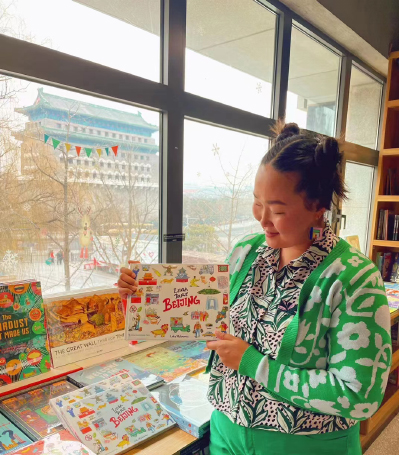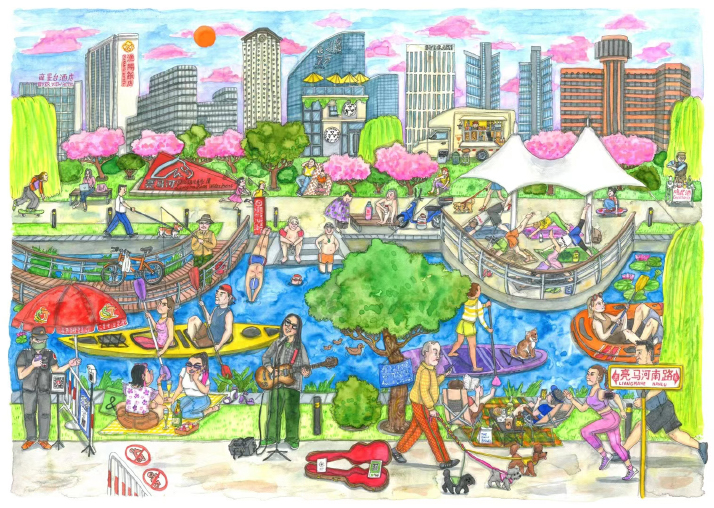A Russian artist observes and paints Beijing

Thirty-something Beijing-based Russian illustrator Liuba Vladimirova loves to catch the sunrise in all its colorful magnificence from a high-rise rooftop or saunter through the hutongs, Beijing's zigzag network of traditional alleyways. The combination of these modern and traditional Beijing flavors serves as the source of her inspiration, propelling her to continuously record the city's hustle and bustle with her brushstrokes.
Widely known by her art brand Liuba Draws, she has been living in Beijing for more than 11 years now. Her watercolor paintings starring Beijing's scenery and residents have even generated byproducts like postcards, key rings and canvas bags, popular among both the capital's Chinese and expat residents. She also published her new book, Liuba Draws Beijing, last November.
For her, Beijing offers a continuous succession of vivid impressions and she expresses her affection for them through painting. "Beijing perfectly combines past, present and future. I enjoy seeing all the little details and inserting them into the paintings, and want to share the beauty of the city with other people," Liuba told Beijing Review.

Painting pizzazz
Liuba was born into a Buryat family, a Mongolic ethnic group native to southeastern Siberia, in Irkutsk, the 25th largest city of Russia in population. She participated in an exchange program in international trade and learned standard Chinese during her studies at Liaoning University in Liaoning Province. After graduation, she decided to go to Beijing and follow her passion to become a full-time illustrator and artist.
"I'm a self-taught illustrator. Around the year 2000, I started learning how to paint. After sharing my paintings with my friends, they began asking me to paint something for them. I like to use watercolor because you can create many colors using different paints and it is easy to fix mistakes," Liuba said.
She has traveled to many regions in China, but Beijing remains her favorite place. "I like to go for a walk and see people chatting and children running. Through these details, I get to experience the real soul of the city," she said.
In 2015, Liuba decided to create a calendar featuring typical Beijing elements—as captured through her eyes. That was when she started focusing on portraying Beijing. She has since released The Beijing Calendar, which has featured 12 new paintings every year over the past eight years.
"In the beginning, only foreigners bought my calendars. But that's slowly changing. More and more young Chinese are buying them. And I feel like more Chinese people are interested in unique things that are created specifically to represent Beijing," Liuba said.
She has painted many of the capital's hottest spots, including building complexes, the Liangma River and 798 Art Zone, portraying people's daily activities and a sense of vivacity.
Liuba first got the idea to publish a book and share her favorite places in and details about Beijing in 2018. The final product, a collection of the artist's firsthand informative and humorous anecdotes, came out last year. It offers readers a glimpse of Beijing—the old maze-like lanes contrasting with the modern skyline, early bird street food vendors and winter wonderland panoramas of the Forbidden City and the Great Wall, to name a few, which are very much unlike the images usually seen in travel guides.
In Liuba's eyes, Beijing is a modern city. "The Beijing subway system is very easy to navigate, super clean and reliable," she said. But tradition has not all faded into obscurity as modernization came along. "In the hutongs you can still see and feel the old ways of life, posing a great contrast to the modern parts of Beijing," she said.
"Fast-paced, constantly changing and never sleeping, Beijing might seem like the perfect city for the young and restless, but older folks, too, enjoy it," she wrote in the book. She has captured how Beijing's seniors entertain themselves, with groups of retirees, mostly women, dancing in unison to loud music in parks and senior men usually playing chess and showing off their physical resilience at the ubiquitous outdoor gyms.
Liuba has also introduced distinctive foods of Beijing, such as the jianbing, a thin and savory crêpe-like pancake. "To start your love affair with Chinese street food, I recommend this savory snack. It is always prepared on the spot to preserve its crispness, which adds to its huge popularity. Part of the jianbing experience is watching how skilled vendors whip up this delicious crêpe in no time right in front of you," she wrote.
Liuba's book is predominantly written in English but some of her explainers are in pinyin, the Chinese phonetic system, so that both Chinese and overseas readers can better understand what the artist wants to convey. She hopes that after reading the book, Chinese readers can better introduce Beijing to people from other countries.

Booming with Beijing
Liuba is also very active on Chinese social media platforms such as leading lifestyle and e-commerce platform Xiaohongshu—literally "Little Red Book." "I like to go to all the beautiful and different locations that many people actually don't know in Beijing, and share them on my social media accounts," she said. Plus, the illustrator's dopamine dressing panache featuring bright and well-collocated colors has gained her many fans. Dopamine dressing is the latest style trend to sweep across Chinese social media. As the name suggests, netizens consider this splashy styling a whimsical way to lift their mood amid the pressures of life and work.
"I love new experiences and that's one of the reasons I like Beijing. I have been to many different cities and countries in Europe over the past decade, and I feel like they have seen very little to no change in the 10 years that have come and gone. But here in Beijing, new things are constantly popping up, like new stores and museums. China has developed at a particularly fast speed and has infinite possibilities," Liuba said.
The changes in the capital's environment, too, have impressed her. "The air quality has drastically improved over the past years. I want to proudly introduce the colorful city I've come to know and love instead of the gray Beijing so very often portrayed," she said.
According to Liuba, Beijing has had a huge impact on her life and personal development. "The metropolis and its people taught me to be patient, expect the unexpected, find joy in the little things, forget about the bad, appreciate what I have, constantly be curious and strive for new experiences," she noted in the book.
Although not sure about her future in Beijing, Liuba feels she has developed close ties with the city. "Beijing and I grew and developed together as partners. Even if Beijing and I decide to break up at some point, I think the city will remain a dear friend whom I'll visit often and give a call sometimes to stay in the loop and find out what's new," she said.
